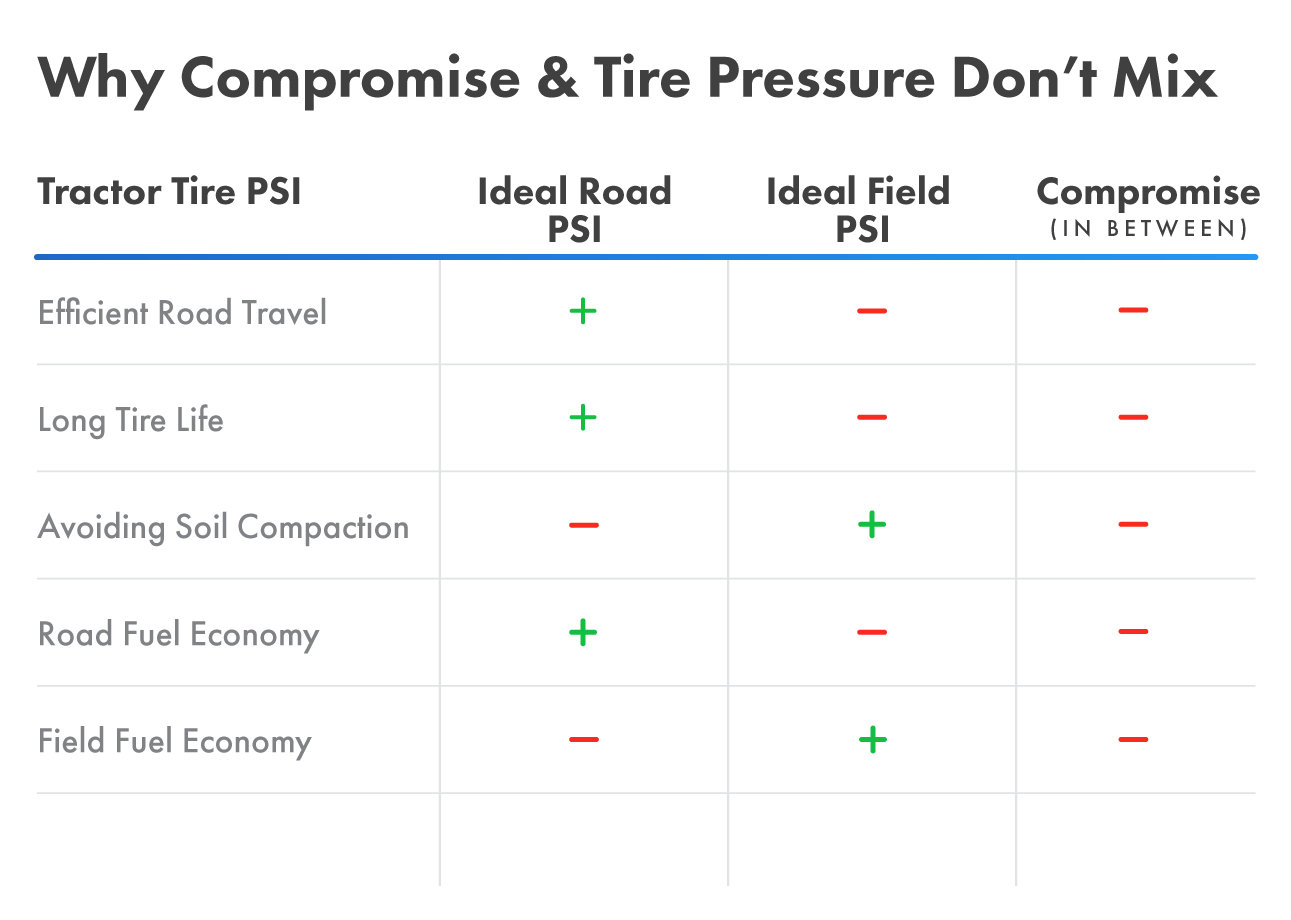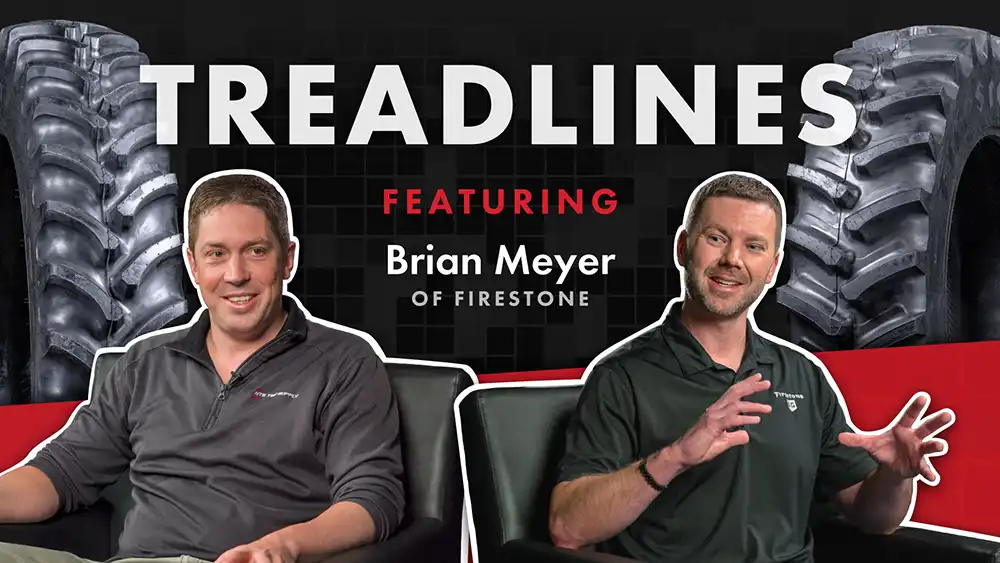Manure tankers are among a handful of farm implements that have a bad reputation for a very obvious reason. No, we don’t mean the smell. We’re talking about weight. Even though the largest tankers may ride on eight flotation tires, they are still a major cause of soil compaction on the farm. It’s unlikely that manure tankers are going to magically become lighter, but there is a strategy to reduce the impact of these huge machines on your fields: Run your tanker’s tires at their lowest safe pressures in the field using a central tire inflation system.

Your Biggest Barrier to Tanker Productivity: One “Fixed” Tire Pressure
To operate your manure tankers safely, you have to set your tire pressures, on both your tractor and tanker, for the worst case scenario you’re going to face for the day. For most farmers, this means setting tire pressures for the road. Run down the road with your tire pressures too low and your tires may overheat and fail. Or at the very least, your manure tanker will pull much harder thanks to the increased rolling resistance.
For the best performance on the road, you need your tires inflated to their maximum psi—as stiff as possible for low rolling resistance and efficient high-speed travel.

However, in the field, you want your tires inflated to their lowest safe psi—as soft as possible for a large, long, stable footprint to minimize compaction.
Since it’s not practical to deflate your manure tanker’s tires when you get to the field—much less inflate them before you head back down the road—you’re probably stuck with your tires inflated at a “compromise” pressure: A pressure that’s somewhere between the ideal road and field pressure for your tanker.
However, tires set to a “compromise” air pressure aren’t optimized for anything.
4 Reasons Your Manure Tanker Needs a Central Tire Inflation System
1. Extend Tire Life
Around 90% of ag tire wear happens on the road. If your tanker’s tires are set to a “compromise” air pressure, your tire investment could go up in smoke. Wear accelerates at an alarming rate when you run underinflated tires down the road. And large tanker tires can also become overinflated as you bomb down the road with heavy loads at high speeds all day. The solution? An inflation system that works to maintain the ideal tire pressure for your tankers and tractors with the push of a button.
2. Save Fuel
If you’re hauling a loaded tanker on underinflated tires down the road, you might as well pull a 10% grade all day. If you’re pulling a tanker through the field on overinflated tires—and sinking into the soil more than necessary—you’re also guzzling more fuel than necessary. Compromise tire pressures hurt your fuel economy and profitability everywhere you go.
3. Pull Easier
Okay, this is related to #2, but it’s worth saying again: Why tax your tractor and inflate your fuel bill when you can outfit your tanker (and tractor) with a central tire inflation system? You’ll save fuel and wear and tear on your tractor’s drivetrain. According to PTG, the company that makes one of the inflation systems we sell, for ever .4 inch your tires sink into the soil, your fuel use climbs by 10 percent.
4. Fight Compaction
Whether you’re custom hauling or tracking across your own land, it pays to fight compaction. If you have the ability to drop your tanker’s (and tractor’s) tires to their lowest safe pressures for the field, your equipment will float better, cause fewer ruts, and even ride better. As their pressures drop, your tanker’s tires deflect to create long, stable footprints that will help minimize compaction. And as you’ll learn below, compaction can cause you or your customers to lose productivity in many, many ways.
10 Ways Compaction Damages Your Soil and Lowers Your Profitability.
No matter how much technology your tires pack, if you’re running them across your fields at pressures that are higher than necessary for the load you’re carrying and the speed you’re traveling, your fields are at risk for compaction. And what’s the end result of compaction? Lost yields and productivity for your farm.

Ultimately, compaction slashes your income because it lowers your yields and increases your costs. How? There are 10 ways that compaction impacts your bottom line.
- Poor drainage. Compacted soil becomes more dense, with less pore space, which means it’s slow to drain water. This means more days when you’re unable to work in the field and more crop problems.
- Fewer soil microbes. More water ponding means cooler and wetter soil, which is less friendly to soil microbes that break down organic matter and make it available to fuel your crops’ growth.
- Fertile topsoil loss. As soil is tightly pressed together, it’s easier for wind and water to carry it away.
- Increased drought risk. Because of the lack of pore space, once water does drain from the soil, very little remains to carry your crop through dry periods.
- Stunted roots. Roots have a hard time moving through packed soil. Smaller root systems = less nutrients and lower yields.
- Late emergence. Plants in compacted areas of the field tend to emerge later. Or not at all if water is ponding in the tire tracks.
- More inputs needed. Compacted soil makes it harder for nutrients to reach your crop, and can cause higher amounts of nitrogen to escape into the air before it can benefit your plants.
- Oxygen starvation. Healthy soil is made up of around 25% air. Throw this ratio off, and your plants will turn yellow—nature’s cautionary color that signals a yield loss in your future.
- Increased fuel costs. Poorly-drained fields require more fuel to work, thanks to the mud. And any time your tractor and/or implements are sinking into the ground, your fuel economy is sinking too.
- Increased maintenance costs. Harder pulling means more wear and tear on equipment.
Read More: An in-depth look at how compaction is costing farmers millions of dollars every year.

Your Best Solution for Tackling Tanker Compaction: A Central Tire Inflation System
When you outfit your manure tanker(s) and tractor with a central tire inflation system, you will finally be in complete control of your tire pressures. You can set optimum tire pressures for both road and field at the touch of a button from your tractor seat. No compromise necessary.
In fact, PTG (the German manufacturer of one of the inflation systems we sell) first broke into the European market on manure tankers. And AgriBrink's owners designed their system with tankers specifically in mind as well (more on that below). Along with sprayers, center-fill planters, and large tractors, manure tankers are perfect candidates for a central tire inflation system because they undergo large swings in weight and speed.
Because their injectors don’t have a wide reach like a sprayer’s boom, tankers end up making frequent passes across any given field. This is why it’s extra important to tackle high tire pressure before it takes a heavy toll on your soil.

Designed for Operators Who Don't Have Time to Wait
You probably realize this, but the key to manure hauling is the hauling. Whether you're a farmer or a custom operator, you don't want to sit still while you wait for your tires to inflate/deflate. The companies that have designed central tire inflation systems have thought of this too. The AgriBrink system, for example, has a 30-second deflate time. Hit the deflate button (or flip the switch) when you're close to the field approach, keep rolling, and you'll soon be at your ideal field pressures to maximize flotation and traction. As far as inflation time, you can work with our CTIS expert to outfit your system with a large enough compressor to suit your needs. Most systems can inflate all the tires on a tractor/tanker combo in 3–5 minutes.
3 Easy Steps to Outfit Your Manure Tanker with a Central Tire Inflation System
- Consult with a CTIS expert at NTS Tire Supply.
- Invest in a system and have our professional installers mount the system on your tanker and/or tractor.
- Enjoy higher levels of performance and higher profitability for your farm or custom hauling business.
PTG vs. AgriBrink
At NTS we sell two brands of central tire inflation systems—PTG and AgriBrink. Iowa-based AgriBrink has been in the central tire inflation game since 2010, when the company owner, originally from the Netherlands, developed his first system for use on his own farm. The company sold its first system in 2012. PTG (PTG Reifendruckregelsysteme GmbH) is based across the pond in Germany. Founded in 1991, PTG has a 30-year history devoted solely to engineering, producing, and selling central tire inflation systems. Today, Michelin owns the company.
While similar in components and operation, the systems have some key differences you'll want to understand to help you decide which one is right for your operation.
Learn all the Details: Farmers' frequently asked questions about central tire inflation systems
What will it cost to install a central tire inflation system on a manure tanker?
The best way to get a quote on a system for a manure tanker is get in touch with NTS Tire Supply. Why? Because there are a number of factors that will influence the final price of a tanker system:
- The style of system (mounted over the tires or through drilled axles)
- The brand of system (PTG or AgriBrink)
- The number of axles your tanker has
- The type of monitor you want (analog, digital, or ISOBUS app)
- The size of compressor you’ll need for fast inflating, which depends on the number and size of tires on your tanker.
Outfitting the tractor you use to pull your tanker is a good idea too.
If you don’t want to install the system yourself, NTS Tire Supply also offers professional installation within 150 miles of our service hubs.

Spread Manure, Not Compaction
If you want to safeguard your soil, prolong tire life, and improve fuel economy while hauling manure, call to speak with our central tire inflation system specialist and we’ll quote a PTG central tire inflation system that will fit your needs and drive your farm forward.

.png)
.jpg)



















